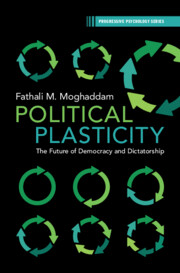Book contents
- Political Plasticity
- The Progressive Psychology Book Series
- Political Plasticity
- Copyright page
- Dedication
- Contents
- Figures
- Preface
- Acknowledgments
- Chapter 1 Political Plasticity, the Key to Understanding the Future of Democracy and Dictatorship
- Chapter 2 Hardwiring inside and outside People
- Part I Political Plasticity and Behavioral Continuity
- Part II Change Agents, in Theory and Practice
- Part III Looking Ahead
- Chapter 12 The Eternal Dictator and Political Plasticity
- Afterword
- Notes
- References
- Index
Chapter 12 - The Eternal Dictator and Political Plasticity
from Part III - Looking Ahead
Published online by Cambridge University Press: 15 January 2023
- Political Plasticity
- The Progressive Psychology Book Series
- Political Plasticity
- Copyright page
- Dedication
- Contents
- Figures
- Preface
- Acknowledgments
- Chapter 1 Political Plasticity, the Key to Understanding the Future of Democracy and Dictatorship
- Chapter 2 Hardwiring inside and outside People
- Part I Political Plasticity and Behavioral Continuity
- Part II Change Agents, in Theory and Practice
- Part III Looking Ahead
- Chapter 12 The Eternal Dictator and Political Plasticity
- Afterword
- Notes
- References
- Index
Summary
Looking to the future, one of the factors that sustains continuity in human behavior is the eternal presence of potential dictators. Individuals with the personality characteristics of dictators are always present in all human groups. When the springboard to dictatorship becomes available, these potential dictators step forward to try to spring to absolute power. The eternally present potential dictator acts as a limiting factor on political plasticity so that progress toward democracy remains stunted, and at times there are reversals from democracy to dictatorship. But the potential dictator is not powerless as to when and how the springboard to dictatorship comes into place. As shown in this chapter, potential dictators use, and sometimes help manufacture, crisis incidents that create societal chaos – then they put themselves forward as the only individuals who can solve the crisis. Hitler used as his crisis incident the 1933 fire at the Reichstag building, Khomeini used the 1979–1980 invasion of the American Embassy in Tehran and the taking over of fifty American diplomats, Putin used the 1990 bombings of apartments in Moscow. In each case, the potential dictator helped to create a crisis, then used the crisis to spring to power. Trump attempted the same in the United States on January 6, 2021.
Keywords
- Type
- Chapter
- Information
- Political PlasticityThe Future of Democracy and Dictatorship, pp. 143 - 153Publisher: Cambridge University PressPrint publication year: 2023



